Ground Reaction Forces, Asymmetries and Performance of Change of Direction Tasks in Youth Elite Female Basketball Players
Abstract
1. Introduction
2. Materials and Methods
2.1. Participants
2.2. Design and Procedures
70° and 180° COD Tests
2.3. Statistical Analysis
3. Results
4. Discussion
5. Conclusions
Author Contributions
Funding
Institutional Review Board Statement
Informed Consent Statement
Data Availability Statement
Acknowledgments
Conflicts of Interest
References
- Dos’Santos, T.; Thomas, C.; Comfort, P.; Jones, P.A. Comparison of Change of Direction Speed Performance and Asymmetries between Team-Sport Athletes: Application of Change of Direction Deficit. Sports 2018, 6, 174. [Google Scholar] [CrossRef]
- Faude, O.; Koch, T.; Meyer, T. Straight sprinting is the most frequent action in goal situations in professional football. J. Sports Sci. 2012, 30, 625–631. [Google Scholar] [CrossRef] [PubMed]
- Maloney, S.J.; Richards, J.; Nixon, D.G.D.; Harvey, L.J.; Fletcher, I.M. Do stiffness and asymmetries predict change of direction performance? J. Sports Sci. 2017, 35, 547–556. [Google Scholar] [CrossRef] [PubMed]
- Impellizzeri, F.M.; Rampinini, E.; Maffiuletti, N.; Marcora, S.M. A Vertical Jump Force Test for Assessing Bilateral Strength Asymmetry in Athletes. Med. Sci. Sport. Exerc. 2007, 39, 2044–2050. [Google Scholar] [CrossRef]
- Grindem, H.; Logerstedt, D.; Eitzen, I.; Moksnes, H.; Axe, M.J.; Snyder-Mackler, L.; Engebretsen, L.; Risberg, M.A. Single-Legged Hop Tests as Predictors of Self-Reported Knee Function in Nonoperatively Treated Individuals with Anterior Cruciate Ligament Injury. Am. J. Sports Med. 2011, 39, 2347–2354. [Google Scholar] [CrossRef] [PubMed]
- Fort-Vanmeerhaeghe, A.; Milà-Villarroel, R.; Pujol-Marzo, M.; Arboix-Alió, J.; Bishop, C. Higher Vertical Jumping Asymmetries and Lower Physical Performance are Indicators of Increased Injury Incidence in Youth Team-Sport Athletes. J. Strength Cond. Res. 2022, 36, 2204–2211. [Google Scholar] [CrossRef]
- Kyritsis, P.; Bahr, R.; Landreau, P.; Miladi, R.; Witvrouw, E. Likelihood of ACL graft rupture: Not meeting six clinical discharge criteria before return to sport is associated with a four times greater risk of rupture. Br. J. Sports Med. 2016, 50, 946–951. [Google Scholar] [CrossRef]
- Paterno, M.V.; Schmitt, L.C.; Ford, K.R.; Rauh, M.J.; Myer, G.D.; Huang, B.; Hewett, T.E. Biomechanical measures during landing and postural stability predict second anterior cruciate ligament injury after anterior cruciate ligament reconstruction and return to sport. Am. J. Sports Med. 2010, 38, 1968–1978. [Google Scholar] [CrossRef]
- Myer, G.D.; Brent, J.L.; Ford, K.R.; Hewett, T.E. Real-Time Assessment and Neuromuscular Training Feedback Techniques to Prevent Anterior Cruciate Ligament Injury in Female Athletes. Strength Cond. J. 2011, 33, 21–35. [Google Scholar] [CrossRef]
- Fox, K.T.; Pearson, L.T.; Hicks, K.M. The effect of lower inter-limb asymmetries on athletic performance: A systematic review and meta-analysis. PLoS ONE 2023, 18, e0286942. [Google Scholar] [CrossRef]
- Bishop, C.; Turner, A.; Read, P. Effects of inter-limb asymmetries on physical and sports performance: A systematic review. J. Sports Sci. 2018, 36, 1135–1144. [Google Scholar] [CrossRef]
- Dos’Santos, T.; Thomas, C.; Jones, P.A.; Comfort, P. Asymmetries in single and triple hop are not detrimental to change of direction speed. J. Trainol. 2017, 6, 35–41. [Google Scholar] [CrossRef] [PubMed]
- Bell, D.R.; Sanfilippo, J.L.; Binkley, N.; Heiderscheit, B.C. Lean Mass Asymmetry Influences Force and Power Asymmetry During Jumping in Collegiate Athletes. J. Strength Cond. Res. 2014, 28, 884–891. [Google Scholar] [CrossRef] [PubMed]
- Lockie, R.G.; Callaghan, S.J.; Berry, S.P.; Cooke, E.R.A.; Jordan, C.A.; Luczo, T.M.; Jeffriess, M.D. Relationship Between Unilateral Jumping Ability and Asymmetry on Multidirectional Speed in Team-Sport Athletes. J. Strength Cond. Res. 2014, 28, 3557–3566. [Google Scholar] [CrossRef] [PubMed]
- Dos’Santos, T.; Thomas, C.; Jones, P.A.; Comfort, P. Assessing Asymmetries in Change of Direction Speed Performance: Application of Change of Direction Deficit. J. strength Cond. Res. 2019, 33, 2953–2961. [Google Scholar] [CrossRef] [PubMed]
- Castagna, C.; Manzi, V.; D’Ottavio, S.; Annino, G.; Padua, E.; Bishop, D. Relation Between Maximal Aerobic Power and the Ability to Repeat Sprints in Young Basketball Players. J. Strength Cond. Res. 2007, 21, 1172. [Google Scholar] [CrossRef]
- Banda, D.S.; Beitzel, M.M.; Kammerer, J.D.; Salazar, I.; Lockie, R.G. Lower-Body Power Relationships to Linear Speed, Change-of-Direction Speed, and High-Intensity Running Performance in DI Collegiate Women’s Basketball Players. J. Hum. Kinet. 2019, 68, 223–232. [Google Scholar] [CrossRef]
- Spiteri, T.; Newton, R.U.; Binetti, M.; Hart, N.H.; Sheppard, J.M.; Nimphius, S. Mechanical Determinants of Faster Change of Direction and Agility Performance in Female Basketball Athletes. J. Strength Cond. Res. 2015, 29, 2205–2214. [Google Scholar] [CrossRef]
- Bahr, R.; Krosshaug, T. Understanding injury mechanisms: A key component of preventing injuries in sport. Br. J. Sports Med. 2005, 39, 324–329. [Google Scholar] [CrossRef]
- Fort-Vanmeerhaeghe, A.; Bishop, C.; Buscà, B.; Vicens-Bordas, J.; Arboix-Alió, J. Seasonal variation of inter-limb jumping asymmetries in youth team-sport athletes. J. Sports Sci. 2021, 39, 2850–2858. [Google Scholar] [CrossRef]
- Bishop, C.; Read, P.; Brazier, J.; Jarvis, P.; Chavda, S.; Bromley, T.; Turner, A. Effects of Interlimb Asymmetries on Acceleration and Change of Direction Speed. J. Strength Cond. Res. 2021, 35, 2095–2101. [Google Scholar] [CrossRef]
- Dos’Santos, T.; McBurnie, A.; Thomas, C.; Comfort, P.; Jones, P.A. Biomechanical Determinants of the Modified and Traditional 505 Change of Direction Speed Test. J. Strength Cond. Res. 2020, 34, 1285–1296. [Google Scholar] [CrossRef] [PubMed]
- Maloney, S.J.; Fletcher, I.M. Lower limb stiffness testing in athletic performance: A critical review. Sport. Biomech. 2021, 20, 109–130. [Google Scholar] [CrossRef] [PubMed]
- Mirwald, R.L.; Baxter-Jones, A.D.G.; Bailey, D.A.; Beunen, G.P. An assessment of maturity from anthropometric measurements. Med. Sci. Sports Exerc. 2002, 34, 689–694. [Google Scholar] [CrossRef]
- Nimphius, S.; Callaghan, S.J.; Spiteri, T.; Lockie, R.G. Change of Direction Deficit: A more isolated measure of change of direction performance than total 505 time. J. Strength Cond. Res. 2016, 30, 3024–3032. [Google Scholar] [CrossRef] [PubMed]
- Koo, T.K.; Li, M.Y. A Guideline of Selecting and Reporting Intraclass Correlation Coefficients for Reliability Research. J. Chiropr. Med. 2016, 15, 155–163. [Google Scholar] [CrossRef]
- Cormack, S.J.; Newton, R.U.; McGuigan, M.R.; Doyle, T.L.A. Reliability of Measures Obtained During Single and Repeated Countermovement Jumps. Int. J. Sports Physiol. Perform. 2008, 3, 131–144. [Google Scholar] [CrossRef]
- Cohen, J. Statistical Power Analysis for Behavioural Science; Lawrence Erlbaum: Mahwah, NJ, USA, 1988. [Google Scholar]
- Hopkins, W.G.; Marshall, S.W.; Batterham, A.M.; Hanin, J. Progressive Statistics for Studies in Sports Medicine and Exercise Science. Med. Sci. Sport. Exerc. 2009, 41, 3–13. [Google Scholar] [CrossRef]
- Cohen, J. A coefficient of agreement for nominal scales. Educ. Psychol. Meas. 1960, 20, 37–46. [Google Scholar] [CrossRef]
- Viera, A.; Garrett, J. Understanding Interobserver Agreement: The Kappa Statistic. Fam. Med. 2005, 37, 360–363. [Google Scholar]
- Dos’Santos, T.; Thomas, C.; Jones, P.A. The effect of angle on change of direction biomechanics: Comparison and inter-task relationships. J. Sports Sci. 2021, 39, 2618–2631. [Google Scholar] [CrossRef] [PubMed]
- Gonzalo-Skok, O.; Dos’Santos, T.; Bishop, C. Assessing limb dominance and inter-limb asymmetries over multiple angles during change of direction speed tests in basketball players. J. Strength Cond. Res. 2023, 37, 2423–2430. [Google Scholar] [CrossRef] [PubMed]
- Dos’Santos, T.; Thomas, C.; Comfort, P.; Jones, P.A. The Effect of Angle and Velocity on Change of Direction Biomechanics: An Angle-Velocity Trade-Off. Sport. Med. 2018, 48, 2235–2253. [Google Scholar] [CrossRef] [PubMed]
- Nagahara, R.; Mizutani, M.; Matsuo, A.; Kanehisa, H.; Fukunaga, T. Association of Sprint Performance With Ground Reaction Forces During Acceleration and Maximal Speed Phases in a Single Sprint. J. Appl. Biomech. 2018, 34, 104–110. [Google Scholar] [CrossRef]
- Arboix-Alió, J.; Bishop, C.; Benet, A.; Buscà, B.; Aguilera-Castells, J.; Fort-Vanmeerhaeghe, A. Assessing the Magnitude and Direction of Asymmetry in Unilateral Jump and Change of Direction Speed Tasks in Youth Female Team-Sport Athletes. J. Hum. Kinet. 2021, 79, 15–27. [Google Scholar] [CrossRef]
- Fort-Vanmeerhaeghe, A.; Benet-Vigo, A.; Montalvo, A.; Arboix, A.; Buscà, B.; Arboix-Alió, J. Relationship between Performance and Inter-Limb Asymmetries Using Flywheel Resistance Device in Elite Youth Female Basketball Players. Biology 2022, 11, 812. [Google Scholar] [CrossRef]
- Wren, T.A.L.; O’Callahan, B.; Katzel, M.J.; Zaslow, T.L.; Edison, B.R.; VandenBerg, C.D.; Conrad-Forrest, A.; Mueske, N.M. Movement variability in pre-teen and teenage athletes performing sports related tasks. Gait Posture 2020, 80, 228–233. [Google Scholar] [CrossRef]
- Fort-Vanmeerhaeghe, A.; Bishop, C.; Montalvo, A.M.; Buscà, B.; Arboix-Alió, J. Effects of Exercise-Induced Neuromuscular Fatigue on Jump Performance and Lower-Limb Asymmetries in Youth Female Team Sport Athletes. J. Hum. Kinet. 2023, 89, 19. [Google Scholar] [CrossRef]
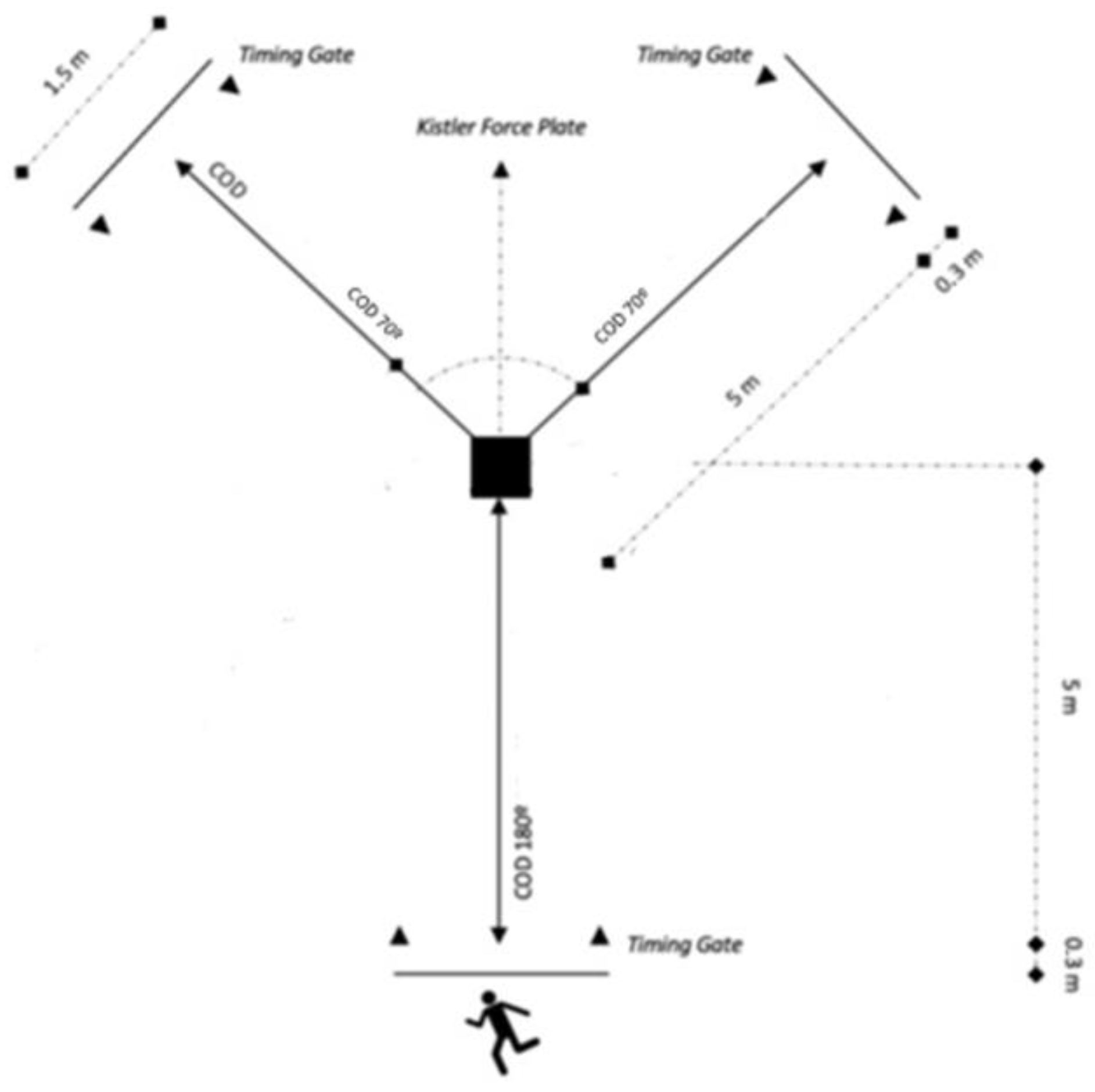
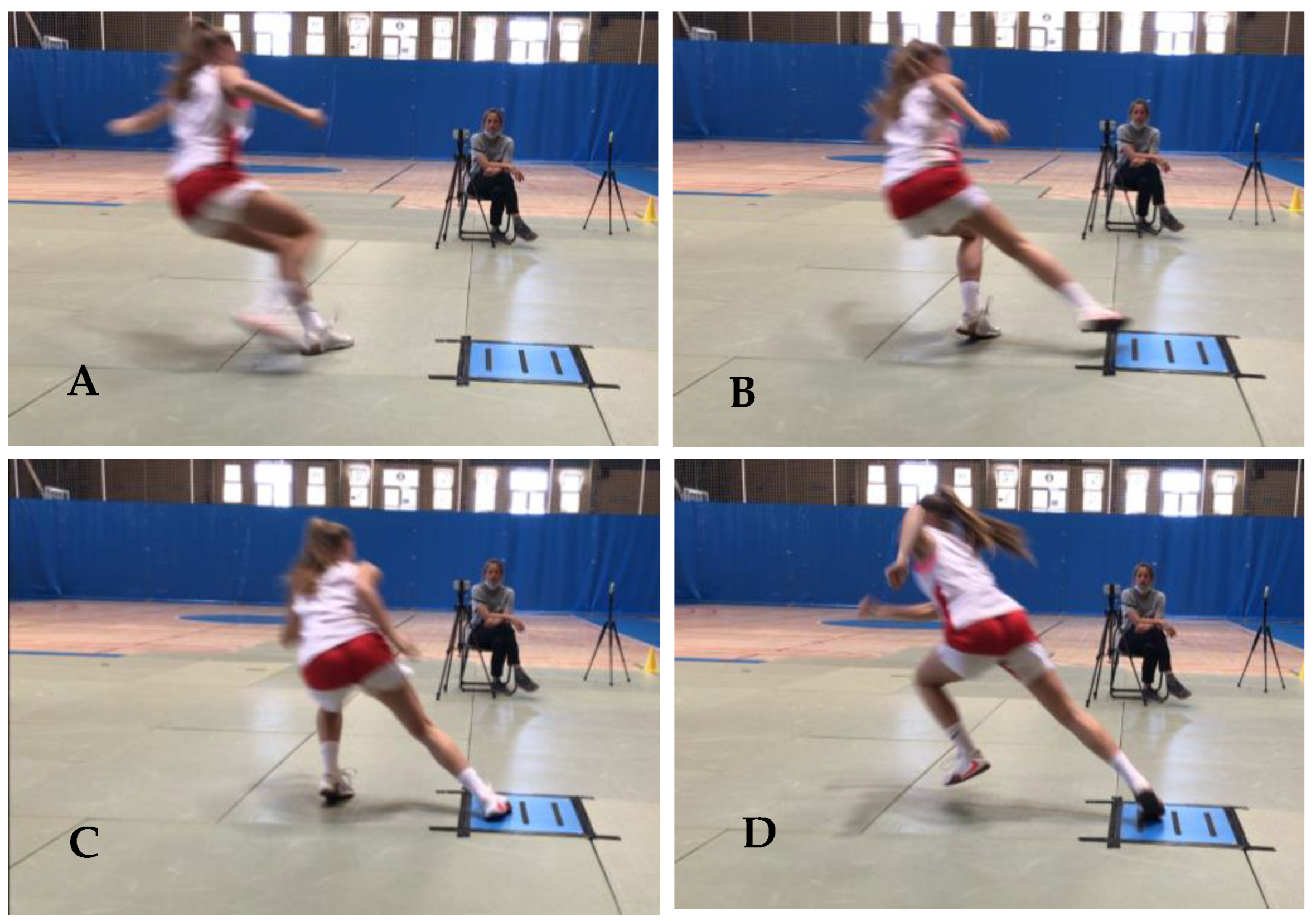
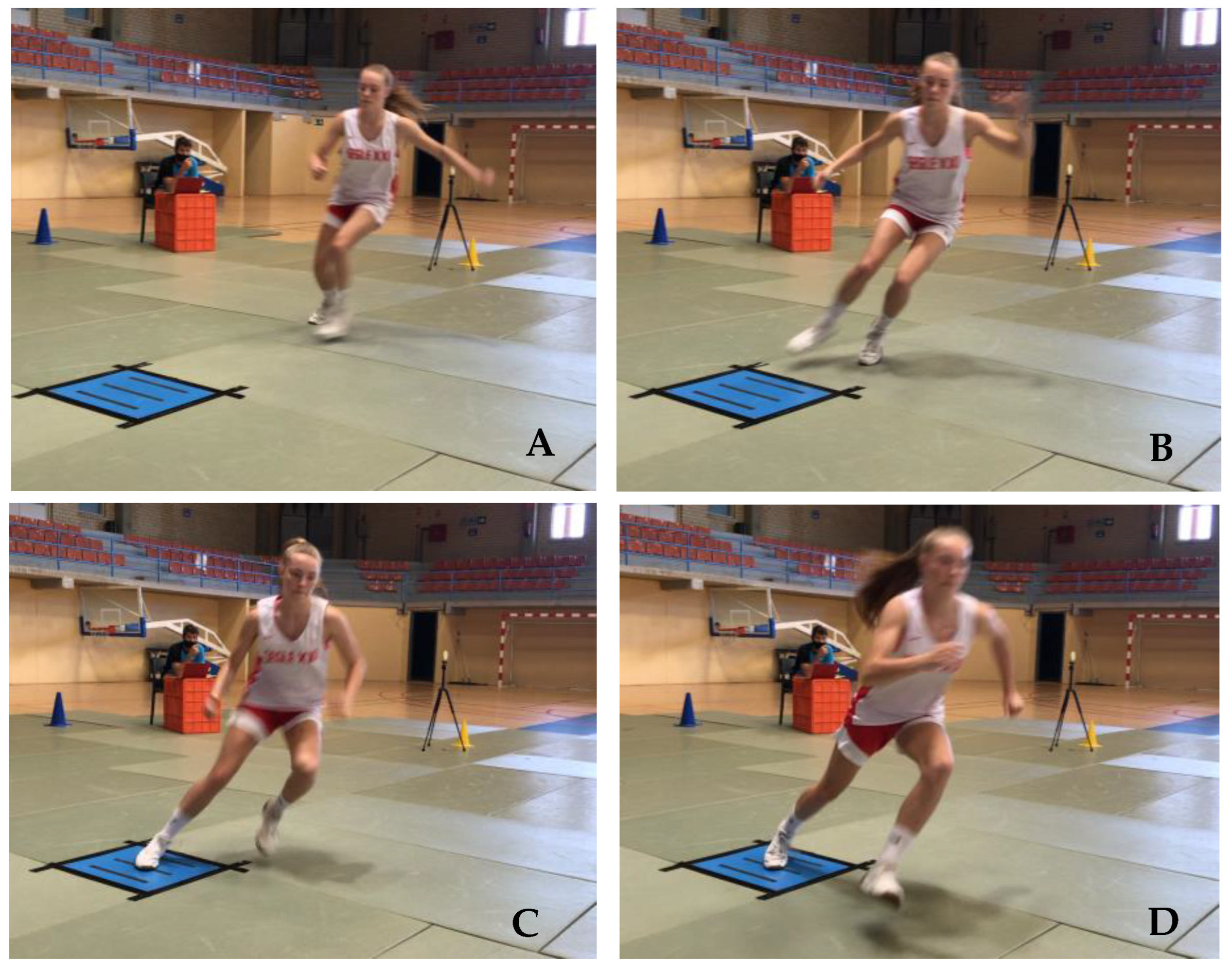
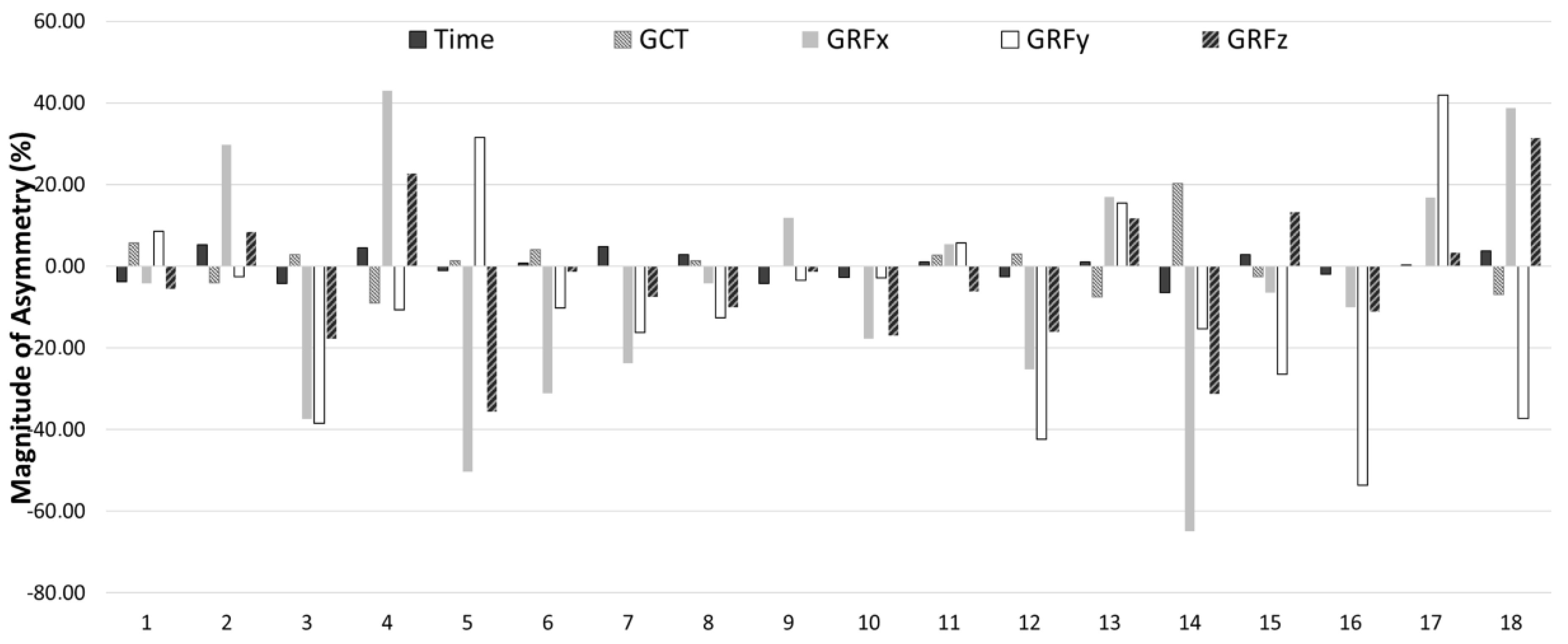
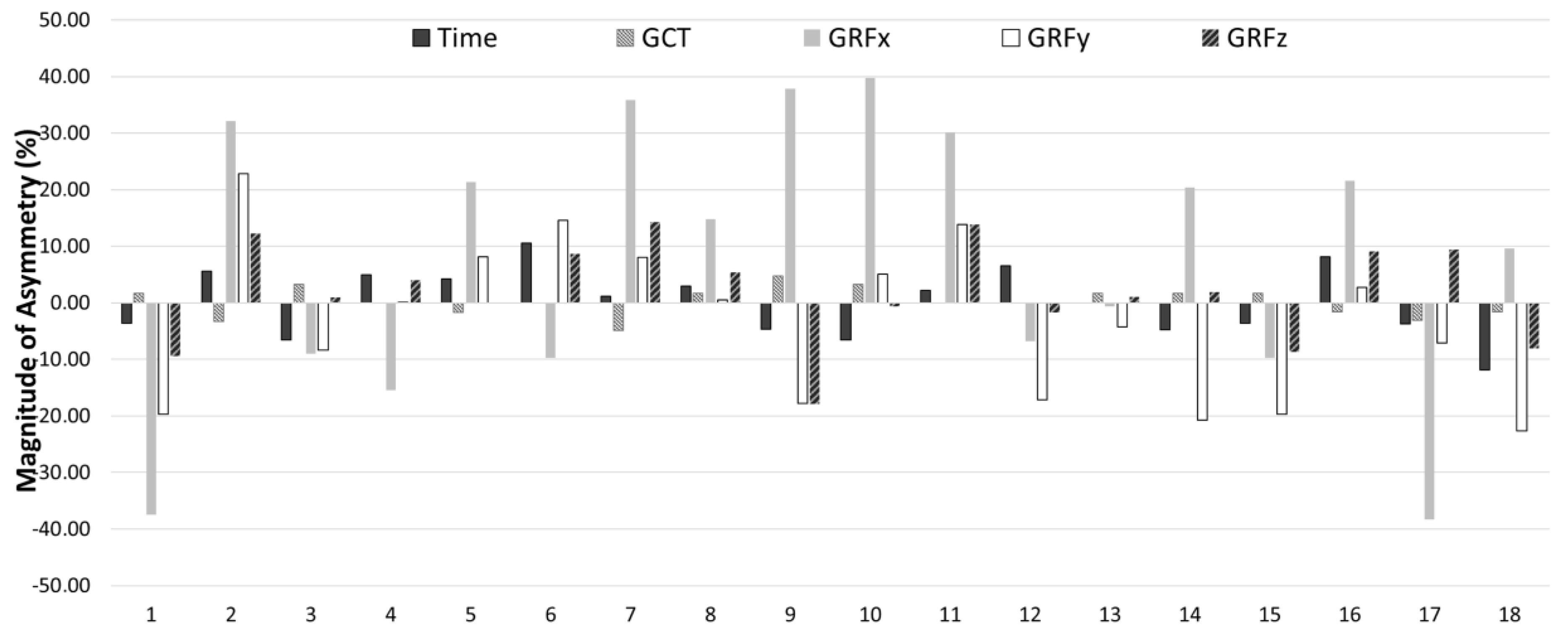
| Test | Variables | Limb | Mean ± SD | ICC (95% CI) | CV (%) |
|---|---|---|---|---|---|
| COD 180° | Time (s) | Right | 2.75 ± 0.15 | 0.91 (0.74–0.96) | 5.41 |
| Left | 2.74 ± 0.15 | 0.88 (0.71–0.92) | 7.44 | ||
| GCT (s) | Right | 0.73 ± 0.04 | 0.82 (0.66–0.90) | 4.51 | |
| Left | 0.73 ± 0.03 | 0.82 (0.64–0.89) | 3.72 | ||
| GRFx (anterior–posterior) | Right | 258.99 ± 107.01 | 0.85 (0.62–0.91) | 4.67 | |
| Left | 282.90 ± 83.30 | 0.84 (0.60–0.87) | 5.54 | ||
| GRFy (mediolateral) | Right | 46.38 ± 33.5 | 0.87 (0.73–0.92) | 4.46 | |
| Left | 50.53 ± 28.45 | 0.86 (0.63–0.95) | 5.21 | ||
| GRFz (vertical) | Right | 841.48 ± 179.40 | 0.79 (0.46–0.92 | 6.01 | |
| Left | 898.76 ± 170.57 | 0.78 (0.41–0.92) | 2.89 | ||
| COD 70° | Time (s) | Right | 2.31 ± 0.17 | 0.91 (0.78–0.97) | 7.52 |
| Left | 2.33 ± 0.13 | 0.94 (0.84–0.98) | 6.41 | ||
| GCT (s) | Right | 0.62 ± 0,02 | 0.94 (0.84–0.98) | 1.32 | |
| Left | 0.61 ± 0.02 | 0.86 (0.62–0.95) | 1.94 | ||
| GRFx (anterior–posterior) | Right | 146.91 ± 52.93 | 0.91 (0.75–0.97) | 2.85 | |
| Left | 139.59 ± 48.37 | 0.90 (0.74–0.96) | 6.89 | ||
| GRFy (mediolateral) | Right | 390.14 ± 61.79 | 0.89 (0.70–0.96) | 1.61 | |
| Left | 401.51 ± 73.22 | 0.93 (0.81–0.97) | 2.64 | ||
| GRFz (vertical) | Right | 1386.44 ± 173.54 | 0.92 (0.80–0.97) | 1.55 | |
| Left | 1349.60 ± 165.95 | 0.89 (0.71–0.96) | 1.75 |
| Time (s) | GCT (s) | GRFx (Anterior–Posterior) | GRFy (Mediolateral) | GRFz (Vertical) | |
|---|---|---|---|---|---|
| HPL | 2.72 ± 0.15 | 0.72 ± 0.03 | 308.59 ± 97.14 | 58.70 ± 31.19 | 932.67 ± 172.42 |
| LPL | 2.79 ± 0.14 | 0.75 ± 0.04 | 226.78 ± 72.84 | 46.57 ± 27.82 | 796.50 ± 152.64 |
| p value | <0.001 | 0.003 | <0.001 | <0.001 | <0.001 |
| ES | 1.78 (1.02–2.53) | 0.82 (0.27–1.35) | 1.18 (0.56–1.78) | 0.98 (0.40–1.54) | 1.24 (0.61–1.85) |
| ASI (%) | 3.02 ± 1.73 | 3.96 ± 4.93 | 24.31 ± 17.39 | 20.9 ± 16.1 | 14.02 ± 10.41 |
| Time (s) | GCT (s) | GRFx (Anterior–Posterior) | GRFy (Mediolateral) | GRFz (Vertical) | |
|---|---|---|---|---|---|
| HPL | 2.27 ± 0.15 | 0.61 ± 0.01 | 164.66 ± 44.26 | 421.18 ± 66.11 | 1422.74 ± 149.24 |
| LPL | 2.39 ± 0.15 | 0.62 ± 0.02 | 129.77 ± 40.94 | 369.85 ± 56.87 | 1323.91 ± 170.17 |
| p value | <0.001 | <0.001 | <0.001 | <0.001 | <0.001 |
| ES | 1.71 (0.96–2.43) | 1.50 (0.81–2.17) | 1.36 (0.71–2.01) | 1.35 (0.69–1.98) | 1.31 (0.65–1.92) |
| ASI (%) | 5.09 ± 3.01 | 1.99 ± 1.51 | 21.7 ± 12.9 | 11.8 ± 7.79 | 7.07 ± 5.40 |
| Test Comparison | Kappa Coefficient | Descriptor |
|---|---|---|
| COD time | 0.143 | Slight |
| GCT | 0.087 | Slight |
| GRFx (anterior–posterior) | 0.024 | Slight |
| GRFy (mediolateral) | −0.111 | Poor |
| GRFz (vertical) | 0.129 | Slight |
Disclaimer/Publisher’s Note: The statements, opinions and data contained in all publications are solely those of the individual author(s) and contributor(s) and not of MDPI and/or the editor(s). MDPI and/or the editor(s) disclaim responsibility for any injury to people or property resulting from any ideas, methods, instructions or products referred to in the content. |
© 2024 by the authors. Licensee MDPI, Basel, Switzerland. This article is an open access article distributed under the terms and conditions of the Creative Commons Attribution (CC BY) license (https://creativecommons.org/licenses/by/4.0/).
Share and Cite
Arboix-Alió, J.; Buscà, B.; Miró, A.; Bishop, C.; Fort-Vanmeerhaeghe, A. Ground Reaction Forces, Asymmetries and Performance of Change of Direction Tasks in Youth Elite Female Basketball Players. Sports 2024, 12, 21. https://doi.org/10.3390/sports12010021
Arboix-Alió J, Buscà B, Miró A, Bishop C, Fort-Vanmeerhaeghe A. Ground Reaction Forces, Asymmetries and Performance of Change of Direction Tasks in Youth Elite Female Basketball Players. Sports. 2024; 12(1):21. https://doi.org/10.3390/sports12010021
Chicago/Turabian StyleArboix-Alió, Jordi, Bernat Buscà, Adrià Miró, Chris Bishop, and Azahara Fort-Vanmeerhaeghe. 2024. "Ground Reaction Forces, Asymmetries and Performance of Change of Direction Tasks in Youth Elite Female Basketball Players" Sports 12, no. 1: 21. https://doi.org/10.3390/sports12010021
APA StyleArboix-Alió, J., Buscà, B., Miró, A., Bishop, C., & Fort-Vanmeerhaeghe, A. (2024). Ground Reaction Forces, Asymmetries and Performance of Change of Direction Tasks in Youth Elite Female Basketball Players. Sports, 12(1), 21. https://doi.org/10.3390/sports12010021









